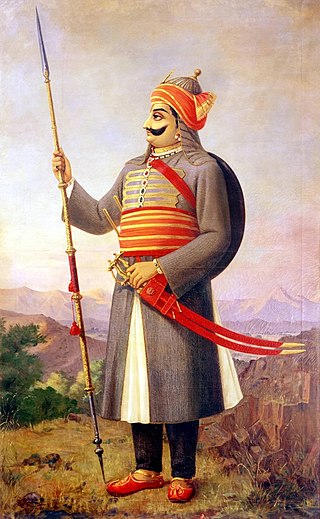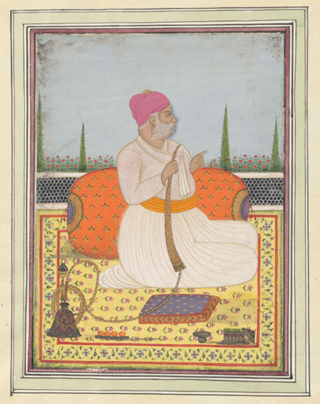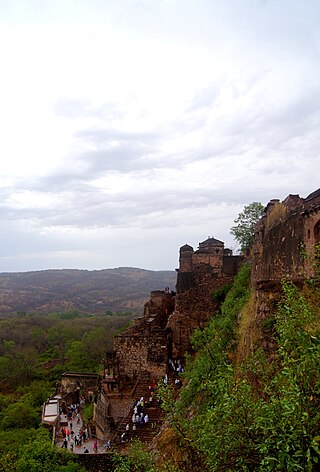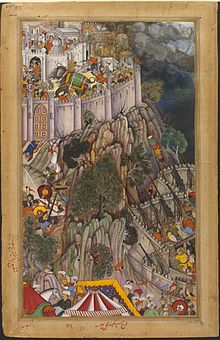
Jauhar, sometimes spelled Jowhar or Juhar, was a Hindu practice of mass self-immolation by women, in the Indian subcontinent, to avoid capture, enslavement and rape by Persian and Afghan Muslim invaders, when facing certain defeat during a war. Some reports of jauhar mention women committing self-immolation along with their children. This practice was historically observed in northwest regions of India, with most famous jauhars in recorded history occurring during wars between Hindu Rajput kingdoms in Rajasthan and the opposing Muslim armies. However jauhar is performed during war, usually when there was no chance of victory. The practice was accompanied by saka, or a last stand in battle.

Pratap Singh I, popularly known as Maharana Pratap, was a king of Mewar, a region in north-western India in the present-day state of Rajasthan. He is notable for leading the Rajput resistance against the expansionist policy of the Mughal Emperor Akbar including the Battle of Haldighati and Battle of Dewair which have turned him into a folk hero across the country.

Suraj Mal was a Jat ruler of Bharatpur in present-day state of Rajasthan. Under him, the Jat rule covered the present-day districts of Agra, Aligarh, Bharatpur, Dholpur, Etawa, Hathras, Mainpuri, Mathura, and Rohtak.

Chittorgarh is a major city in Rajasthan state of western India. It lies on the Berach River, a tributary of the Banas, and is the administrative headquarters of Chittorgarh District. It was a major stronghold of the Rajput State of Medapata. The city of Chittorgarh is located on the banks of river Gambhiri and Berach.
Bundi is a city in the Hadoti region of Rajasthan state in northwest India and capital of the former princely state of Rajputana agency. District of Bundi is named after the former princely state.

Rao Maldeo Rathore was a king of the Rathore dynasty, who ruled the kingdom of Marwar in present day state of Rajasthan. Maldeo ascended the throne in 1531 CE, inheriting a small ancestral principality of Rathore's but after a long period of military actions against his neighbours, Maldeo swept significant territories which included parts of present day Rajasthan, Haryana, Uttar Pradesh, Gujarat and Sindh. He refused to ally with either the Sur Empire or the Mughal Empire.

The Chittorgarh, also known as Chittod Fort, is one of the largest forts in India. It is a UNESCO World Heritage Site. The fort was the capital of Mewar and is located in the present-day city of Chittorgarh. It sprawls over a hill 180 m (590.6 ft) in height spread over an area of 280 ha above the plains of the valley drained by the Berach River. The fort covers 65 historic structures, which include four palaces, 19 large temples, 20 large water bodies, 4 memorials and a few victory towers.

Ranthambore Fort lies within the Ranthambore National Park, near the city of Sawai Madhopur in Sawai Madhopur district of Rajasthan, India. the park being the former hunting grounds of the Maharajahs of Jaipur until the time of India's Independence. It is a formidable fort having been a focal point of the historical developments of Rajasthan. The fort is believed to be constructed by numerous kings from Several Dynasties including Yadav lineage, Chahamana Rajputs, Hada Rajputs, Mewar Rajput Kings and then the Delhi Sultanate captured it for a brief time. The fort provides a panoramic view of the surrounding Ranthambore National Park and is now a popular tourist attraction.

The history of human settlement in the west Indian state of Rajasthan dates back to about 5,000 years ago. Around 1400 BC, the Matsya tribe occupied the region. Parts of Rajsthan also belonged to the site of the Indus Valley Civilization. The early medieval period saw the rise of many Rajput kingdoms such as the Chauhans of Ajmer, Sisodias of Mewar, Gurjara-Pratihara and the Rathores of Marwar, as well as several Rajput clans such as the Gohil and the Shekhawats of Shekhawati. While Jat kingdoms include the Johiya of Jangaldesh, the Sinsinwars of Bharatpur State, as well as the Bamraulia clan and the Ranas of Dholpur.

The Kingdom of Mewar, sometimes known as Udaipur State, was an independent kingdom in Rajputana region of India, ruled by the Sisodia dynasty. It was established around the 7th century by the minor rulers of the Nagada-Ahar region of Udaipur and later, in the 10th century, it transformed into an independent state under Rawal Bharttripatta II.

Naruka is a clan of Rajputs found in India. Naruka Rajputs are offshoots of Maharao Naru Singh of Mozamabad, whose grandfather, Rao Bar Singh, gave up the throne of Amer kingdom. Rao Bar Singh was the eldest son of Raja Udaikarna of Amer. Naruka is the most prominent clan among Kachhwaha and holds an exceptional position in the history of India. They independently ruled on Alwar State.

Bundi State was founded by Hada Rao Devda currently located in modern-day Rajasthan. It was ruled by Hada Chauhans Rajputs.

The siege of Chittorgarh was the military expedition of the Mughal Empire under Akbar against the Mewar kingdom that commenced in 1567 during which the Mughals successfully captured the fort of Chittorgarh after a hard-pressed siege which lasted for several months.
The Mughal–Rajput Wars were a series of battles fought between the Rajput Confederacy and the Mughal Empire which started with the Timurid ruler Babur's invasion of northwestern India and the head of the Rajput confederacy Rana Sanga's resistance to it. In 1526, when Babur invaded Hindustan, he faced stiff resistance from Rana Sanga in the Battle of Bayana, but defeated Rana in the Battle of Khanwa in 1527. The wars were, however, continued by the Rajput states, also by the descendants of both Rana Sanga and Babur. Babur's grandson Emperor Akbar the Great faced heavy resistance from Rana Udai Singh II and Rana Pratap. But in 1576 Akbar achieved a decisive victory in the Battle of Haldighati led by Man Singh I, a Rujput descent turned ally of the Mughal Empire. The victory led to tremendous gains for the Mughal Empire. Subsequently Mughals and Rajputs established a peaceful relation with Emperor Akbar accepting many Rajput leaders into Mughal court and giving them top political positions.
Hindu Rajput kingdoms in the Northern and Western Indian subcontinent tried to resist the Muslim invasion of India, beginning with the Umayyad campaigns entering from the Middle East and the Ghaznavid Turks from Ghazni. They continued resistance against subsequent Muslim empires, including the Abbasids, Ghurids, Mamluks, Khiljis, Tuglaqs, Sayyids, Lodis, Suris and Mughals.
Timeline of history of Rajasthan

Jaimal Rathore (1507–1568) was the Rathore ruler of Merta. He was cousin of the Hindu saint Mirabai and became the ruler of Merta after the death of his father, Rao Veeram Dev. His father was perceived as the strongest king of the east in his time. The Amar Kavya records that Udai Singh II granted Badnor along with 210 villages to Rao Jaimal. In 1553, Jaimal resisted falling under the chakri of Maldeo of Marwar.
Siege of Ranthambore may refer to:
Rao Surjan Singh was the 14th Raja of Bundi. He was crowned in 1554.













